
Dwarf citrus tree care
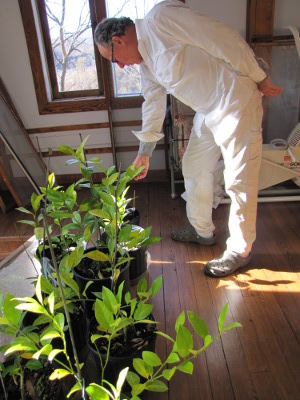 If
you kill your spiderplants, you probably won't want to buy a dwarf
citrus tree. Potted citrus plants are going to produce quite a
bit of food for you, so they require a proportionate amount of care.
If
you kill your spiderplants, you probably won't want to buy a dwarf
citrus tree. Potted citrus plants are going to produce quite a
bit of food for you, so they require a proportionate amount of care.
Light
In a perfect world, your
citrus tree would like to have full sun.
Most growers move their plants outside into a sunny spot for the
summer, but in the winter you'll need either a south-facing window or a
grow light to keep your tree happy. Although I've read that Meyer
lemons
want 8 to 14 hours of direct sun per day, our tree fruits quite
well for us even though it probably only gets about 6 hours of real sun
in the dead of winter. But don't think you're going to be able to
grow a dwarf citrus tree in a shady living room --- allot sixteen
square feet in your sunniest window.
Pots and soil
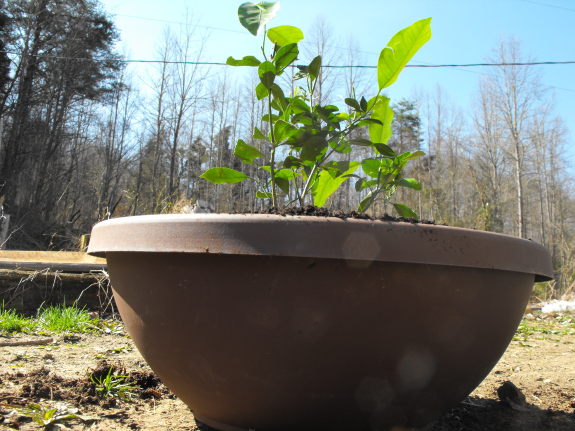 I
like to start young dwarf citrus trees in pots like the one shown
here. The wide, bowl-shape is perfect since dwarf citrus produce
very
shallow roots and just ignore the soil in the bottom of deeper
pots. Once the tree needs more space, I'll pot it up into
a 10 gallon pot, which is about as big as Mark and I like to go.
You'll get a beautiful tree and scads of fruits if you pot your
tree up yet again into a 15 gallon pot, but it's dicey maneuvering such
a huge plant inside for the winter.
I
like to start young dwarf citrus trees in pots like the one shown
here. The wide, bowl-shape is perfect since dwarf citrus produce
very
shallow roots and just ignore the soil in the bottom of deeper
pots. Once the tree needs more space, I'll pot it up into
a 10 gallon pot, which is about as big as Mark and I like to go.
You'll get a beautiful tree and scads of fruits if you pot your
tree up yet again into a 15 gallon pot, but it's dicey maneuvering such
a huge plant inside for the winter.
If you're going to buy
soil, there are special citrus blends
available. I like to make my own potting soil from a mixture of
stump
dirt, worm
castings, and
composted horse manure. No matter what
you do, don't dig up dirt out of your yard, put it in a pot, and expect
your citrus tree to thrive. In such a confined space, you need
light, fluffy soil with a great cation
exchange capacity,
which
generally means lots of organic matter (or vermiculite.)
Feeding and watering
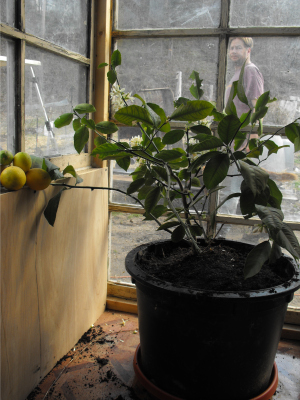 Once
your dwarf citrus trees get old enough to fruit (often in the
first or second year), they are hungry eaters. My neighbor gets
awesome results with storebought chemical liquid citrus
fertilizer. I don't like to buy things, so I get nearly as good
results by feeding my tree with watered
down urine, compost
tea, or
worm tea (depending on what I have on hand at the time.)
For best results, feed your tree once a week in lieu of watering it.
Once
your dwarf citrus trees get old enough to fruit (often in the
first or second year), they are hungry eaters. My neighbor gets
awesome results with storebought chemical liquid citrus
fertilizer. I don't like to buy things, so I get nearly as good
results by feeding my tree with watered
down urine, compost
tea, or
worm tea (depending on what I have on hand at the time.)
For best results, feed your tree once a week in lieu of watering it.
Speaking of watering,
citrus trees are like most house plants --- they
hate getting too much water. For best results, water your tree
whenever the soil feels dry an inch or two below the surface.
(Just stick your finger into the dirt.) Only water enough that
you'll need to give the tree another drink in a week or less.
Another frequent mistake
is to let your plant sit in a saucer of water
so that the bottom third of the soil in the pot is saturated with water
and unusable by the tree. One way to get around this is to drill
a few holes in the side of
your pot an inch or so from the bottom. Now your saucer will
overflow if you water too much (oops), but you won't fill the plant's
growing area up with water.
Indoors and outdoors
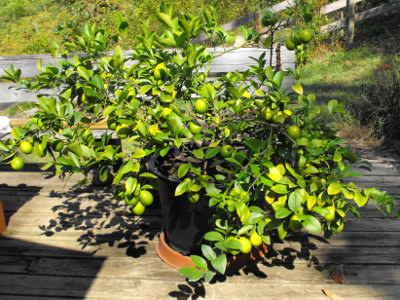 Dwarf citrus trees fall prey
to the usual banes of houseplants ---
scale, aphids, whiteflies, etc. You can go to great lengths to
delete these pest insects, but I prefer a simpler approach. As
soon as the last frost has passed in the spring, I move my houseplants
outside and let my garden's army of beneficial insects eat all the bad
bugs up.
Dwarf citrus trees fall prey
to the usual banes of houseplants ---
scale, aphids, whiteflies, etc. You can go to great lengths to
delete these pest insects, but I prefer a simpler approach. As
soon as the last frost has passed in the spring, I move my houseplants
outside and let my garden's army of beneficial insects eat all the bad
bugs up.
Growing your dwarf
citrus trees indoors in the winter and outdoors in the summer has other
benefits as well as insect control.
The extra sunlight gives your trees lots of energy to put out fruits,
and rains naturally cleanse the leaves. (Since citrus trees are
evergreens, their leaves can become dusty if raised solely indoors.)
Don't move your citrus
plants outside prematurely, though. They
can tolerate temperatures just above freezing for short periods, but
prefer 55 to 85 degrees Fahrenheit.
Pruning
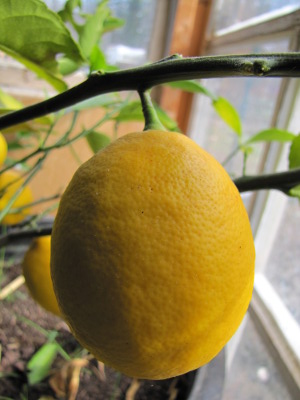 How (or whether) you prune
your Meyer lemon depends on the size
you wish it to attain. In addition to the
tips here, you'll
want to prune away branches that cross or shade
other ones, just like you would with a fruit tree outdoors. You
can also decide whether to prune your Meyer lemon into an erect tree
shape or to let it grow as more of a bush with lots of branches that
arch up and then droop down with the weight of their fruits. If
you choose the latter route, most auhorities suggest training to the
three strongest trunks.
How (or whether) you prune
your Meyer lemon depends on the size
you wish it to attain. In addition to the
tips here, you'll
want to prune away branches that cross or shade
other ones, just like you would with a fruit tree outdoors. You
can also decide whether to prune your Meyer lemon into an erect tree
shape or to let it grow as more of a bush with lots of branches that
arch up and then droop down with the weight of their fruits. If
you choose the latter route, most auhorities suggest training to the
three strongest trunks.
The only reason your
tree would definitely need pruning is if it
sprouts below the graft union. Even if you can't pick out the
scar on the tree's trunk where the scionwood was grafted onto the
rootstock, you'll know the rootstock has sprouted if you see three-part
leaves instead of
simple leaves on your tree. Prune back all of
the rootstock sprouts and keep an eye on the tree since they may
come back.
| This post is part of our Dwarf Citrus lunchtime series.
Read all of the entries: |
Want more in-depth information? Browse through our books.
Or explore more posts by date or by subject.
About us: Anna Hess and Mark Hamilton spent over a decade living self-sufficiently in the mountains of Virginia before moving north to start over from scratch in the foothills of Ohio. They've experimented with permaculture, no-till gardening, trailersteading, home-based microbusinesses and much more, writing about their adventures in both blogs and books.
Want to be notified when new comments are posted on this page? Click on the RSS button after you add a comment to subscribe to the comment feed, or simply check the box beside "email replies to me" while writing your comment.

- Remove comment
- Remove comment
- Remove comment
- Remove comment
- Remove comment
